Online Learning Capacity Building Institute (2018)
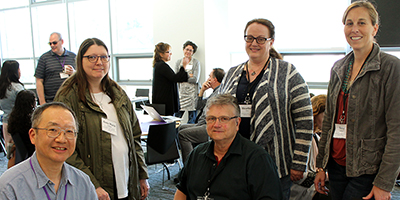
Proceedings of the June 2018 Online Learning Capacity Building Institute (CBI)
This publication shares the proceedings of the Washington State Online Learning Capacity Building Institute that was held on June 26, 2018, at the University of Washington, Seattle. The content may be useful for people who
- participated in the CBI,
- create online learning tools,
- promote the inclusive design of online learning technology and practices through the application of universal design principles and strategies,
- seek to increase their understanding of issues surrounding the participation of students with disabilities in online learning options,
- would like to access resources to help make their online learning tools welcoming to, accessible to, and usable by everyone, including those with disabilities, and/or
- have promising practices to share with others.
This event was sponsored by UW Accessible Technology Services (ATS) at the University of Washington (UW), a UW-IT (University of Washington Information Technology) unit that directs both the Access Technology and DO-IT (Disabilities, Opportunities, Internetworking, and Technology) Centers. The meeting was facilitated by Dr. Sheryl Burgstahler, the director of ATS.
ATS’s two Centers are dedicated to empowering people with disabilities through technology and education. They promote awareness and accessibility to maximize the potential of individuals with disabilities and make our communities more vibrant, diverse, and inclusive.
The DO-IT Center strives to
- increase the success of people with disabilities in challenging academic programs and careers;
- promote the application of universal design to physical spaces, information technology, instruction, and services;
- freely distribute online content, publications, and videos for use in presentations, exhibits, and the classroom; and
- provide resources for students with disabilities, K-12 educators, postsecondary faculty and administrators, librarians, employers, parents, and mentors.
The Access Technology Center (ATC) focuses on ensuring UW students, faculty, and staff with disabilities have the same access to technology—including computers, software, and special equipment—as other students, faculty, and staff. ATC staff help individuals select and use assistive technology and supports a showroom with numerous products:
- speech and braille output
- screen magnification
- alternatives to the keyboard and mouse
- speech recognition software
- tools to make reading and writing easier and computer use more comfortable
- the capacity to create documents in e-text and braille
The showroom includes a collection of accessible science equipment such as automatic stirrers, tactile measuring devices, and talking calculators. The ATC provides braille embossing and tactile graphics for the UW community.
ATC staff promote the development and use of accessible technology products by
- encouraging student computing facilities to include assistive technology;
- offering courses, delivering presentations, and conducting ATC tours for UW classes and other groups;
- working with campus units to prepare documents, videos, and other materials in accessible electronic formats;
- assisting campus web developers in designing accessible websites and applications;
- working with vendors of IT products used by the UW to improve accessibility; and
- supporting a central resource to provide guidance to technologists and administrators at the UW and beyond.
About the CBI
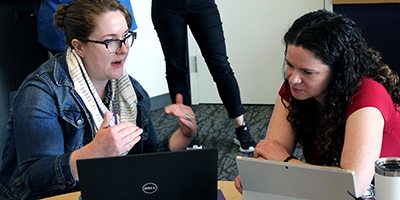
The Online Learning CBI brought together instructors, administrators, and technology developers, to share ideas and expertise regarding instruction and use of creation of online learning tools that create welcoming and accessible experiences that everyone can use and participate in, including those with disabilities. Most attendees represented colleges and universities across Washington State. More than 60 people attended the event.
The CBI provided a forum for discussing recruitment and access challenges, sharing expertise and successful practices, developing collaborations, creating resources, and identifying systemic change initiatives relevant to the meeting’s goals. Topics discussed included
- the engagement of people with disabilities in online learning and what instructors need to know;
- the development of new technologies;
- web accessibility;
- document accessibility;
- approaches to access—accommodations and universal design;
- student perspectives on diverse student needs, research, and tools;
- maximizing student engagement; and
- lessons learned and promising practices.
In small group discussions, participants responded to the following questions: What barriers do you face on your campus related to ensuring that online learning is accessible and usable for people with disabilities? What are some possible solutions?
In this CBI
- all participants contributed to its success,
- experts in all topic areas were in the audience, and
- new concepts evolved from discussions.
The CBI was comprised of presentations, panel discussions, and group discussions. CBI participants shared their diverse perspectives and expertise. The agenda for the CBI and summaries of the presentations are provided on the following pages.
CBI Agenda
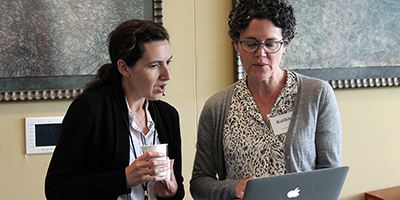
8:30 – 9:00 am
Light Breakfast and Networking
9:00 – 9:30 am
Welcome, Introductions, and Meeting Goals with Sheryl Burgstahler, University of Washington
9:30 – 10:30 am
Overview of Accessibility Issues for Online Learning for Different Stakeholders (e.g., designers, instructors, administrators, students, …) with Sheryl Burgstahler
10:45 – 12 noon
Web and Video Accessibility with Terrill Thompson, University of Washington
12:00 – 1:00 pm
Lunch & Table Discussions:
- What barriers do you face on your campus related to ensuring that online learning is accessible and usable for people with disabilities?
- What are some possible solutions?
Write responses on handouts
1:00 – 1:30 pm
Discuss Outcomes from Lunch Discussion
1:30 – 2:45 pm
Accessibility of Canvas and Creating Accessible Documents, with Dan Comden, Hadi Rangin, and Gaby de Jongh, University of Washington
3:00 – 4:00 pm
Panel of Participants Sharing Promising Practices for Making Online Learning Accessible to All Students and Instructors, Including Those with Disabilities
- Ana Thompson, University of Washington, Bothell
- Claver Hategekimana, Skagit Valley College
- Doug Hayman, University of Washington
- Gaby de Jongh, University of Washington
4:00 – 5:00 pm
Conclusion & Plans for the Future
- Evaluation
Presentation Summaries
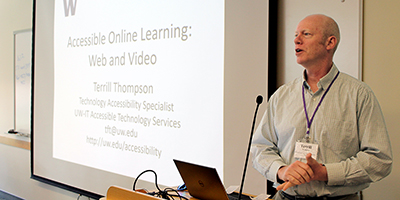
Overview of Accessibility Issues for Online Learning for Different Stakeholders (e.g., designers, instructors, administrators, students, …)
Presented by Sheryl Burgstahler, University of Washington
Educational institutions across the nation are under scrutiny for failing to offer accessible online classes and resources. Many civil rights complaints have been made because information technology (IT) is not accessible to individuals with disabilities—including uncaptioned videos, unreadable PDFs, and inaccessible websites and information kiosks. The legal basis for these civil rights complaints is Section 504 of the Rehabilitation Act of 1973, the Americans with Disabilities Act (ADA) of 1990 and its 2008 amendments, and local and state laws (e.g., Policy #188 in Washington State). Policy #188 on IT accessibility helps guide us as we work to comply with federal laws and collaborate in our efforts to ensure that the IT we develop, procure, and use is accessible to all faculty, students, staff, and visitors, including those with disabilities.
Ability exists on a continuum, where all individuals are more or less able to see, hear, walk, read print, communicate verbally, tune out distractions, learn, or manage their health. Most disabilities are invisible and many students and staff don’t report their disabilities to disability service offices. Regardless of where a person falls on this continuum and whether they request accommodations, we want to ensure that they have access to the classes we teach and resources we share.
According to the U.S. Department of Justice and the Office of Civil Rights of the U.S. Department of Education, “accessible” means “a person with a disability is afforded the opportunity to acquire the same information, engage in the same interactions, and enjoy the same services as a person without a disability in an equally effective and equally integrated manner.”
There are two approaches for making our campuses accessible: accommodations and universal design. Accommodations are reactive and allow us to address the inaccessible features of a product or environment to make it more accessible to an individual who finds it inaccessible (e.g., captioning a video when a student with a hearing impairment requests it). Universal design is a proactive approach to create all aspects of a product or environment as accessible as possible as it is being designed. A building that is technically accessible would have a separate ramp for people with wheelchairs, while a building that is universally designed would have one entrance that is accessible for all. Universally designed technology builds on accessibility, is flexible, and is compatible with assistive technology.
I taught my first online class in 1995. This was a class on adaptive technology for people with disabilities. I taught the class with a professor, Dr. Norm Coombs, who is blind. We took steps to make it as accessible as possible to showcase that it was possible for any student to take an online course. I still do this in the online classes I teach today.
While educators may not have the choice in their learning management system (LMS), they do have the choice to create accessible instructional materials and teaching strategies. Educators should consider if everyone can gain knowledge, interact, and demonstrate their knowledge. The first step towards this is creating an accessible syllabus with structure and key information, including a statement on accessibility and disability-related accommodations. A good place for educators to find guidance in where to begin making a course accessible is in DO-IT’s publication, 20 Tips for Teaching an Accessible Online Course.
Another resource for leaders in online learning programs is the Ten Indicators of Distance Learning Program Accessibility web resource, which tells how distance learning program administrators nationwide can work toward achieving fully accessible distance learning programs. The Distance Learning Program Accessibility Indicators can be used as a checklist for documenting programmatic changes that lead to improved accessibility of the courses of any distance-learning program.
Web and Video Accessibility
Presented by Terrill Thompson, University of Washington
When we’re creating digital content such as web pages or online documents, we may envision our typical user as an able-bodied person using a desktop computer. In reality, users utilize a wide variety of technologies to access the web, including assistive technologies and mobile devices. Everyone has a unique combination of levels of ability when it comes to seeing, hearing, or using a mouse or keyboard; there is a wide variety of technology and software tools that people use to access information online. But are courses always accessible to or usable by students or instructors using assistive technology? In order to ensure our digital resources are accessible, designers, developers, and content authors must understand that users are technologically diverse, and familiarize themselves with a few simple accessibility standards, tools, and techniques.
For content, plain text is not always the most accessible format. Simple structure like headings and lists can allow people with or without assistive technology to understand the information provided. Most tools for providing content allow for structural coding. Since the World Wide Web was invented, HTML has included the option to add alternative text to describe the content of images, proper heading structures, and other accessibility features. The W3C Web Content Accessibility Guidelines (WCAG) 2.0 aims to make all web content accessible to all users. WCAG 2.0 follows four main principles; information should be perceivable, operable, understandable, and robust. Each of these principles is defined by more specific guidelines, and those are further defined by specific success criteria, each assigned Level A, AA, or AAA. Level A success criteria includes the most critical issues for accessibility and requirements are fairly easy to meet when compared with Level AA and AAA. In resolution agreements with postsecondary campuses and the U.S. Department of Justice and the OCR, WCAG 2.0 Level AA is typically the accepted level of website accessibility.
Using accessible tools and design strategies will help make all web content more accessible. Using accessible themes in WordPress and Drupal is an easy way to spread accessibility across campus, when those themes incorporate accessibility features such as keyboard accessible drop-down menus and proper headings. If websites include rich, dynamic content (as opposed to static documents), ensuring their accessibility will likely depend on use of Accessible Rich Internet Applications (ARIA), a markup language that supplements HTML with attributes that communicate roles, states, and properties of user interface elements to assistive technologies. Creating an accessible online course could be simplified into the following five steps:
- Use headings.
- Add alternate text to images.
- Caption and audio-describe videos.
- Upload accessible course materials.
- Ask questions about accessibility before selecting other features or tools:
- Don’t ask “Is this accessible?” Closed questions yield too little information.
- Instead, ask them to describe what they’ve done to ensure their product meets WCAG 2.0 Level AA requirements.
- Ask them to demonstrate their technology without a mouse or using assistive technology such as a screen reader.
For more information about web accessibility, check out these resources:
- 30 Tips for Improving Web Accessibility
- Accessible Technology at the UW
- Accessible University Demo Site
Accessibility of Canvas and Creating Accessible Documents
Presented by Dan Comden, Hadi Rangin, and Gaby de Jongh, University of Washington
Learning Management Systems
There are two layers of accessibility issues, the application framework layer and the content layer. In an LMS, both layers must be accessible to have provide good user experience. We have collaborated with major LMS vendors including Canvas, Moodle, Blackboard, and Desire2Learn and helps to improve the accessibility of all these LMS’s.
All these major LMS vendors have invested significant resources into accessibility. They are not perfect in this regard, but they are much better than they were at any time in the past.
Regarding accessibility approaches to content, we have two options:
- Reactive approach: You let your campus disability services office provide accommodations to a specific student or instructor.
- Proactive approach: You provide equal and real-time access to all learning materials by creating accessible materials and teaching strategies during the design process and providing real-time learning experiences for students that are similar to that of their peers.
The proactive approach can save time and labor in the long run by avoiding expensive accommodations, as well as providing equal access to students in a timely manner.
Since the LMS can typically be accessible, instructional designers and faculty just need to focus on content accessibility, as well as accessibility issues as they select specific tools and employee teaching strategies.
Canvas
In 2016, Hadi Rangin began and continue to lead a focus group called Canvas Accessibility Testing and Evaluation Project (CATE), which includes several higher education institutions. We conduct accessibility tests and share accessibility challenges with Instructure, the developer and distributor of Canvas. Instructure was very receptive to our input and has addressed most reported issues by fixing them or partially redesigning the relevant components/functions. Canvas has demonstrated a solid commitment to accessibility since we have been collaborating with them. There are four non-negotiable criteria supported by the Canvas leadership according to the Canvas product lead: global, scalable, secure, and accessible. Their accessibility features include solid ARIA landmarks, keyboard accessibility, good navigation within courses and modules, accessibility in new or recreated components (to-do lists for students, calendar, gradebook, discussion forum), and the Accessibility Checker. The Accessibility Checker allows content creators to check for accessibility of the content they create and allows them to use the Canvas rich text editor to remediate the issues. At this time the Accessibility Checker checks for 11 known accessibility problems. Canvas has open-sourced this extension and the community is welcome to add new features to it.
Content
HTML is always the most accessible format for content. It has a comprehensive set of semantic tags, includes fully accessible forms, accessible math via MathML, accessible videos and a wide variety of other accessibility features. Next, Microsoft Word and PowerPoint have a variety of accessibility features, including stylistic accessibility tags, alt text for images, simple accessible tables, accessible math via the MathType plugin, and an accessibility checker, and are well-supported by assistive technology. However, accessibility in Word has some limitations compared to HTML, for example with forms and complex tables.
With Microsoft products, there are some basic steps to make an accessible document:
- Use built-in heading styles (Heading 1, Heading 2, etc.) You can change the look of a style via the “Modify Style” dialog in the Styles panel. For lengthy documents, create a Table of Contents from the heading styles.
- Use tables wisely. Identify row headers and keep your tables simple.
For PowerPoints, use built-in theme templates. If you need to change a template, edit the master slide, but don’t uncheck the title or footer boxes.
- Check your reading order of slide contents. Go into the Selection Pane and verify your content goes in order from the bottom to the top. Also title slides differently from each other.
- Make hyperlinks accessible. Use smart links by highlighting text that should be linked and using the Insert Hyperlinks dialogue box to insert links.
- Use alt text for visuals. Alt text can come with some limitations and challenges, especially for science information. Consider the effective practices for Description of Science Content.
- Use the built-in accessibility checker. It finds errors, warnings, and tips in .docx, .pptx., and .xlsx.
- When you export your Word, PowerPoint, or Excel document to PDF, preserve the structure to keep it accessible.
The most widely used format for sharing documents in online courses is PDF. PDFs come in three types: inaccessible image, a document with text but no structure, and a “tagged PDF,” a document with an underlying tag structure similar to HTML. A well-structured, tagged PDF can be fairly accessible, and Adobe Acrobat includes an accessibility checker to help authors check and fix accessibility problems. However, PDF has some limitations: It does not support accessible math, accessibility in forms is extremely limited compared to HTML, and its accessibility features are only supported by screen readers in Windows.
There are a few basics you can use to create accessible PDFs. WCAG 2.0 Level AA is the standard for accessibility, the PDF/UA is the standard intended to make the content within a PDF available for accessibility, and the PAC 3 validates for accessibility. PDFs are usually created by a source document, either from an authoring tool or a scanned image. Always make sure to use the accessibility features in the original authoring tool (e.g., Word or InDesign). It is always easier to create an accessible source document than remediating a non-accessible document. If working from a scanned document, you can use Adobe’s built-in optical character recognition (OCR), but OCR is imperfect and may result in inaccurate text, particularly if the scanned page is skewed or includes markings.
Always consider the hierarchy of tasks for a new PDF document:
- Is it a scanned document? Use OCR.
- Does it have form fields? Add the form field controls using Acrobat.
- Does it have hyperlinks? Add links using the Create Links tool.
- Does it have multimedia? Add the multimedia tools and include alt text, captions, or video description.
The latest version Adobe Acrobat Pro has the ability to fully remediate a PDF. It can convert a scanned image to text, autotag a document, and make it accessible via the Action Wizard. All of these steps should be double checked and confirmed. You then use the Touch Up Reading Order tool via the Order Panel, where you can manually add and clean up tags (tinyurl.com/PDFtags). You should always review that lists, images, tables, links, and forms are tagged properly. You can use the Acrobat accessibility checker to confirm these as well as remind you to manually check color contrast, reading order, and document language.
Resources
Microsoft Accessibility
Adobe Acrobat Pro DC
- PDF Accessibility Overview
- Accessibility Repair Workflow
- Using the Accessibility Checker
- Accessible Forms and Interactive Documents
InDesign Accessibility Basics
Lynda.com
Panel Presentation Summary
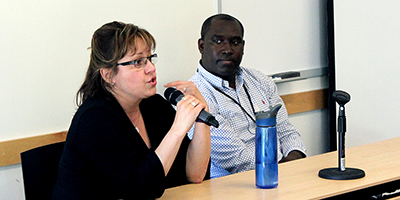
Panel of Participants Sharing Promising Practices for Making Online Learning Accessible to All Students and Instructors, Including Those with Disabilities
- Ana Thompson, University of Washington, Bothell
- Claver Hategekimana, Skagit Valley College
- Susie Hawkey and Doug Hayman, University of Washington
- Gaby de Jongh, University of Washington
Accessible Design in Canvas
Ana Thompson, University of Washington, Bothell
Principles of Accessible Design in Canvas
Canvas is a very accessible format because it uses HTML and adapts to different devices. It also prints out URLs when using descriptive links. Canvas course content can also be transferred quickly to different courses and kept accessible. Canvas is user friendly and easy to update. Follow these accessibility guidelines when using Canvas:
- Use headings for semantic structure.
- Use ALT text for images or mark them as decorative.
- Use built-in lists.
- Use sans serif fonts and avoid using all caps.
- Do not convey meaning by color alone and make sure there is sufficient color contrast.
- Use descriptive hyperlinks.
- Use simple tables for data only with marked rows and columns.
- Be consistent and clear in course layout and navigation.
- Caption videos.
Make course syllabi clear, complete, easy to retrieve, and accessible to all students. Follow these steps to create an accessible syllabus in Canvas:
- Make the layout simple and uncluttered and use clear and descriptive headings (with page titles set to H1 and section headings set to H2).
- Use the built-in lists within the rich text editor when you create a list.
- Include contact information, course description and learning objectives.
- Make the syllabus easily retrievable via the course navigation either via one page or a book of pages. The syllabus link should be used to connect to the calendar and weight of graded assignments. Consult an example of an accessible syllabus at canvas.uw.edu/courses/1113665/pages/week-1.
Resources
- Rello, L. and Baeza-Yates, R. (2013). Good fonts for dyslexia. ACM Press. https://doi.org/10.1145/2513383.2513447
- National Center on Disability and Access to Education. (2018). Creating accessible electronic content. (2018). Retrieved from http://ncdae.org/resources/cheatsheets/electronic-content.php
- Canvas Doc Team (2018). Add and modify text in the text editor. Retrieved from https://community.canvaslms.com/t5/Instructor-Guide/How-do-I-add-and-modify-text-in-the-Rich-Content-Editor-as-an/ta-p/818
- Canvas Doc Team. (2017). How do I use the syllabus as an instructor? Retrieved from https://community.canvaslms.com/t5/Instructor-Guide/How-do-I-use-the-Syllabus-as-an-instructor/ta-p/638
Accessibility Demo Examples
Claver Hategekimana, Skagit Valley College
Skagit Valley College has developed a Course Accessibility Checklist, which can be followed when creating a new course. Below are some steps and examples to consider when making your course accessible:
- Textbooks, syllabus, and handouts: Make sure the textbook is available from the bookstore, has alternative formats, and isn’t used on the first day of class. Include an accessibility statement in the syllabus.
- Audio and video: Make sure all audio presentations are available in transcript and all videos are captioned.
- Webpages and LMS: Confirm clear layout with formatted headings. Do not include flashing content and avoid drag and drop activities.
- Use of color and images: Use strong contrast, do not use colors to deliver information, and provide alt tags to describe images.
- Canvas: Use the accessibility checker that’s built into Canvas, or use third party alternatives such as University of Central Florida’s UDOIT or Blackboard Ally.
- Testing: Accommodate students who require extra time or alternative formats via your disabilities services office. Consider adjusting the testing tool to allow for multiple attempts.
- Technology in classroom: Allow students to use technology for learning activities. Students may use their phones or laptops to take notes or record presentations.
UW Captioning Service
Doug Hayman, University of Washington
Many videos on campuses are captioned only as an accommodation for a person who is deaf or hard of hearing, even though they benefit many others, including English language learners, those with reading-related disabilities, and individuals who simply want to see the spelling of words spoken in the presentation. The University of Washington’s ATS Free Captioning Service promotes proactive captioning of videos on campus. By offering free captioning, the ATS is increasing the number of videos captioned on campus, educating stakeholders, and raising awareness of the importance of captioning and the processes involved adding captions to videos. The service team secured central funding, justifying it as promoting a best practice in education as well as helping the campus meet its legal obligations.
This service has worked on hundreds of hours of video content across the University. Learn more about it and apply at Creating Accessible Technology.
The Case for Ally
Gaby de Jongh, University of Washington
A significant number of documents are created by UW faculty each quarter and many of these are often inaccessible and provide barriers for students with disabilities. During Winter Quarter 2018, 3817 classes were offered in Canvas, using a total of 349,058 documents (an average of 91 documents per class). On average per quarter (based on Winter 2018):
- Scanned but no OCR: 17,498
- Contrast Issues: 57,345
- Untagged: 51,213
- No Headers: 38,134
- Images without Alt text: 36,781
- Average pages per quarter (not including science, technology, engineering, and mathematics content!): 3,207,315
- Average number of hours spent fixing inaccessible documents at DRS: 32,073 hours (an average of $481,097 per quarter)
Solutions
- Many campuses have purchased Blackboard Ally, an LMS plugin created to identify inaccessible documents and other features of an online course.
- Ally can also convert PDF documents to text-based documents, but is not capable of ensuring proper formatting for full accountability.
- This tool can be confusing to instructors, so it is important to collaborate with department chairs and program coordinators to offer training regarding accessible content. Train content creators, administrators, librarians, and others to remove basic accessibility barriers.
Question and Answer
What is SensusAccess and is it a worthwhile tool?
SensusAccess is an easy tool to correct PDFs and other documents into a more accessible format. However, it is automated for remediation. It can assign heading levels and format lists, but does not do well with tables and some other aspects of documents. It can be useful to individuals who need an alternative format of a document when the disability services office is not available to help.
Which course survey tool is the most accessible?
ATS staff looked at Google Forms, Microsoft Office Forms, Catalyst WebQ, Survey Monkey, Survey Gizmo, etc. We checked basic required fields, radio buttoms, likert scale, etc. None of these tools are perfect. They all have made some effort to improve accessibility of their HTML forms, but they all have problems. ATS has filed bugs with the various vendors, in hopes of improving the situation.
How is YouTube accessibility compared to other platforms?
Computer-generated captions are easy to edit by the video owner. However, if you are not the owner, it can be hard to start the dialogue with the channel owner to fix the captions. For videos that do have captions, YouTube is excellent at providing users with flexibility to control the appearance of the caption text, including font size, color, background color, and transparency.
I realized I should be including accessibility requirements for my students as well. Do we have any lessons or curriculum on accessibility topics that can be used for various classes?
Highlight a few things, such as captions or heading structures in documents. Include accessibility topics within the learning objectives and reference accessibility issues throughout the course. Some possible content can be located through the DO-IT Knowledge Base at www.uw.edu/doit/ knowledge-base
Can you address accessibility in relation to Google Docs and Google Sheets?
Google Docs support accessibility features such as headings and alt text for images. However, if you export to PDF Google does not create a “tagged PDF”, therefore all accessibility features are lost. There’s a third-party plugin called Grackle Docs (www.grackledocs.com/) that fixes this shortcoming; it also includes an accessibility checker and other features that enhance accessibility within Google Docs.
Discussion Summary
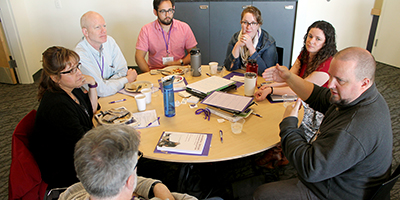
What barriers do you face on your campus related to ensuring that online learning is accessible and usable for people with disabilities? What are some possible solutions?
Participants identified various barriers and solutions to those barriers, shared below:
Barrier: Faculty feel overwhelmed with accessibility requirements.
Solution: Implement a plan for new faculty to receive training and then slowly bring in instructors of existing curriculum. Allot more time for professional development for faculty to learn about accessibility.
Barrier: There is resistance to change due to time restraints, lack of knowledge and training opportunities, and siloed departments.
Solution: Gather advocates to promote accessibility. Integrate accessibility within regular work flows so that it is a part of everyone’s job instead of just one person’s job.
Barrier: There is a lack of training in accessibility in technology and knowledge of laws.
Solution: Consider offering compensation and other incentives to faculty to encourage them to teach accessibly, including credits or certifications.
Barrier: How can we get faculty interested and excited about accessibility?
Solution: Bring in a panel of students with disabilities to share their difficulties in accessing courses and suggest improvements that would increase that access.
Barrier: How do we find and remediate inaccessible course content, including making sure all videos have captions?
Solution: Provide resources (money and time) and assign responsibilities for making sure all content is made accessible. Review courses and hold faculty accountable for making their materials accessible.
Barrier: Faculty worry accommodations (e.g., extra time on time-limited quizzes) will allow students to cheat.
Solution: Use technology that prevents cheating or create more open-ended tests and assignments where cheating is more difficult.
Barrier: Faculty consider a conflict between “academic freedom” and “civil rights.”
Solution: Explain that helping students achieve success levels the playing field without lowering standards and interfering with academic freedom.
CBI Participants
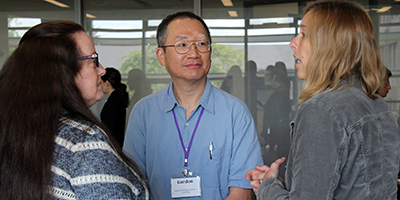
Multiple stakeholder groups were represented in the CBI. The following individuals from Washington State colleges and universities participated in the CBI.
Alisa Shtromberg
Website/Digital Content Manager
Lake Washington Institute of Technology
Ana Thompson
Learning & Access Designer, Office of Digital Learning & Innovation
UW Bothell
Anna Marie Golden
IT Accessibility Specialist, Accessible Technology Services
University of Washington
Annabell DuMez-Matheson
Assistant Director, Disability Support Services
Seattle Pacific University
Betsy Zahrt Geib
Instructional Designer, eLearning
Bellevue College
Brenda Grell
Instructor, Creative Media and Digital Culture Program
Washington State University Vancouver
Bruce Wolcott
Instructional Designer of eLearning, Communication Studies
Bellevue College
Bryna Lieberman
Organization Development and Training Specialist, UW Libraries
University of Washington
Christine Lloyd
Associate Faculty
Everett Community College
Claver Hategekimana
Director of eLearning
Skagit Valley College
Dan Comden
ATC Manager, Accessible Technology Services
University of Washington
Dave Reeves
Teaching & Learning Systems Manager
Walla Walla University
David Crook
Information Technology Specialist 3, Extended Education
Western Washington University
Doug Hayman
Senior Computer Specialist, Accessible Technology Services
University of Washington
Elizabeth Lee
Program Operations Specialist, Accessible Technology Services
University of Washington
Erin Latona
Assoc. Prof./Arts & Humanities Coordinator
Pierce College
Gaby de Jongh
IT Accessibility Specialist, Accessible Technology Services
University of Washington
Gordon Hom
Digital Learning Coordinator, eLearning
Bellevue College
Hadi Rangin
IT Accessibility Specialist, Accessible Technology Services
University of Washington
Heather Rane
eLearning Center Assistant, Library, Media & eLearning
Bellevue College
John Buell
Learning Systems Administrator
Seattle University
Jon McGough
Associate Director, Disability Resources
Western Washington University
JungSoo Kim
Visiting Scholar, DO-IT Center
University of Washington
Karen Park
Associate Director of Educational Technology & Media, Library; Assistant Vice President of Education; Assistant Vice President of Special Projects and Faculty Development
Seattle Pacific University
Kathleen Sullivan
UW Master of Library and Information Science Candidate
University of Washington
Kathryn Slaybaugh
Educator, Child Development
Everett Community College
Kevin Dixey
Instructional Designer of Special Projects
Western Washington University
Kyle Peirson
Educational Technology Specialist, Center for Engagement and Learning
Pierce College
Lyla Crawford
Program Coordinator, Accessible Technology Services
University of Washington
Lynette Sorenson
Education Technologist
Northwest University
Mafil Fabroquez
Senior Administrative Assistant, Center for Digital Learning & Innovation
Seattle University
Marisa Petrich
Instructional Design Librarian
University of Washington Tacoma
Megan Tedell-Hlady
Training and Education Specialist, Human Subjects Division (Part of the Office of Research)
University of Washington
Melisa Ziegler
Coordinator of Organizational Learning and Adjunct Professor
Tacoma Community College
Meredith Inocencio
Director, Access Services; ADA Coordinator
The Evergreen State College
Michael Stiber
Professor, Computing & Software Systems
UW Bothell
Nancy Weiner
Learning Technologies Specialist, Continuum College
University of Washington
Rhonda DeWitt
Coordinator, Employee Training
Lake Washington Institute of Technology
Shannon Potter
Full-time Faculty, English to Speakers of Other Languages
Olympic College
Sheryl Burgstahler
Director, Accessible Technology Services
University of Washington
Stacy Alvares
Part-time Biology Professor
Edmonds Community College
Sue Huett
DSS Coordinator
Walla Walla University
Susie Hawkey
Operations Manager, Accessible Technology Services
University of Washington
Sylvia Nosworthy
Professor of English
Walla Walla University
Terrill Thompson
Technology Accessibility Specialist, Accessible Technology Services
University of Washington
Traci Grant
Director Academic Success and Advising
Northwest University
Tye Durbin
LMS Admin/Accessibility Support
Whatcom Community College
Wendy Steele
Multimedia Designer and Accessible Technology Manager
WSU
Yun Moh
Instructional Designer and Faculty
Seattle Central College
Zoe Fisher
Instructional Designer, Pierce College
Pierce College
Communities of Practice
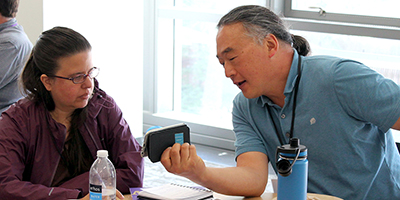
UW Accessible Technology Services engages stakeholders within Communities of Practice (CoPs). CoP members share perspectives and expertise and identify practices that promote the participation of people with disabilities in postsecondary education.
Accessible IT CoP
This CoP is populated with disability services and IT professionals interested in increasing the accessibility of IT in postsecondary education, particularly in Washington State. Participants
- exchange information, ideas, and suggestions for future collaboration,
- gain and share knowledge and help identify issues related to IT accessibility in higher education, and
- recruit others to participate in the CoP.
Universal Design in Higher Education CoP
This CoP is comprised of individuals interested in exploring universal design (UD) and its applications in higher education. Participants on this CoP discuss
- promising practices for infusing universal design on postsecondary campuses;
- applying UD to all educational opportunities that include instruction, technology, student services and physical spaces; and
- specific topics in the book Universal Design and Higher Education: From Principles to Practice and contribute materials to be shared through the Center on Universal Design in Education.
Accessible Distance Learning CoP
Distance learning program administrators, instructors, and support staff use the Accessible Distance Learning CoP to increase their knowledge about disabilities and make changes in distance learning that lead to more inclusive practices. Members discuss
- management,
- staffing,
- training, and
- policy issues related to creating accessible distance learning courses and programs.
You and your colleagues can join the CoP by sending the following information to doit@uw.edu:
- name
- position/title
- institution
- postal address
- email address
- name of the CoP
For information about other CoPs, consult Communities of Practice.
Resources
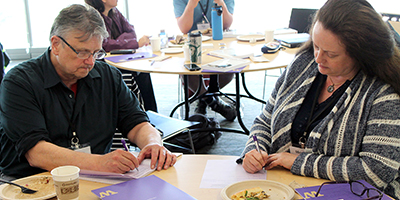
The UW’s Accessible Technology website includes a variety of resources:
- the IT accessibility policy and guidelines for the UW
- legal issues and civil rights complaints and resolutions nationwide
- instructions and tips for making IT accessible
- more resources for creating and procuring accessible IT products
The DO-IT (Disabilities, Opportunities, Internetworking, and Technology) website contains the following:
- information about DO-IT projects
- evidence-based practices that support project goals and objectives
- resources for students with disabilities
- educational materials for teachers and administration
DO-IT maintains a searchable database of frequently asked questions, case studies, and promising practices related to how educators and employers can fully include students with disabilities. The Knowledge Base is an excellent resource for ideas that can be implemented in programs in order to better serve students with disabilities. In particular, the promising practices articles serve to spread the word about practices that show evidence of improving the participation of people with disabilities in postsecondary education.
Examples of Knowledge Base questions include the following:
- Are electronic whiteboards accessible to people with disabilities?
- Are peer review tools accessible?
- Do postsecondary institutions have to provide assistive technology (for example, screen enlargement or voice recognition software) to students with disabilities who enroll in distance learning courses?
- Does making our school web content accessible mean I cannot use multimedia on my site?
- How can educational entities determine if their websites are accessible?
Individuals and organizations are encouraged to propose questions and answers, case studies, and promising practices for the Knowledge Base. Contributions and suggestions can be sent to doit@uw.edu.
For more information on making your campus technology accessible and to learn more about accessible learning or universal design, review the following websites and brochures:
- The University of Washington’s hub for information on accessible technology, featuring how to create and develop accessible documents, videos, and websites, can be found at Accessible Technology.
- WCAG 2.0 are the expected guidelines to be followed for all websites.
- The Access Technology Center’s website.
- A list of thirty different web accessibility tips, and how to implement those tips, can be found at 30 Web Accessibility Tips.
- Accessibility training and certification.
- Cheat sheets for making accessible documents and content, as well as a plethora of other resources for accessible websites, can be found at The National Center on Disability and Access to Education.
- The AccessDL website shares resources for making distance learning and online courses accessible.
- Accessible University’s website featuring common web accessibility principles and solutions.
- A brochure on universally designing distance-learning programs can be found at Equal Access: Universal Design of Distance Learning Programs.
- A brochure on what accessible distance learning is and how it helps students can be found at Accessible Distance Learning.
- A brochure on the top tips for creating an accessible distance-learning course can be found at 20 Tips for Teaching an Accessible Online Course.
- More information on universal design in education can be found at the Center for Universal Design in Education.
Conferences can be a great way to share resources, collaborate, and come up with new ideas. Consider attending the following nation-wide conferences:
Acknowledgments
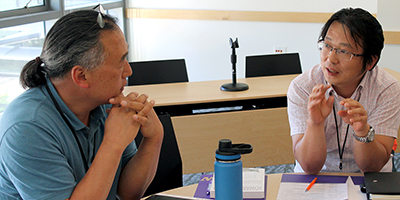
The Washington State Online Learning Capacity Building Institute was funded by Access Technology Services at the University of Washington. Any opinions, findings, and conclusions or recommendations expressed in this material are those of the CBI presenters, attendees, and publication authors and do not necessarily reflect the views of the University of Washington.
Accessible Technology Services
University of Washington
Box 354842
Seattle, WA 98195-4842
www.washington.edu/accessibility/
www.washington.edu/doit/
206-685-3648 (voice/TTY)
888-972-3648 (toll free voice/TTY)
206-221-4171 (FAX)
509-328-9331 (voice/TTY) Spokane
© 2018 University of Washington. Permission is granted to copy this publication for educational, noncommercial purposes, provided the source is acknowledged.